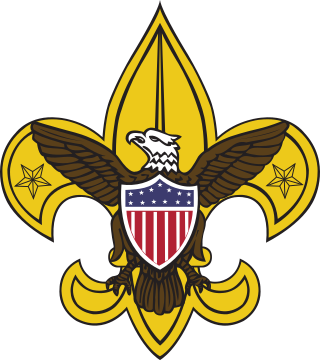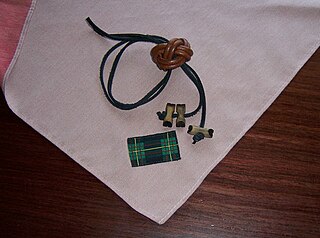
The Boy Scouts of America is one of the largest scouting organizations and one of the largest youth organizations in the United States, with over 1 million youth, including 176,000 female participants. The BSA was founded in 1910; about 130 million Americans have participated in its programs. Served by 477,000 adult volunteers. BSA became a founding member organization of the World Organization of the Scout Movement in 1922.

A Scout is a child, usually 10–18 years of age, participating in the worldwide Scouting movement. Because of the large age and development span, many Scouting associations have split this age group into a junior and a senior section. Scouts are organized into troops averaging 20–30 Scouts under the guidance of one or more Scout Leaders or Scoutmasters. Troops subdivide into patrols of about 6–8 Scouts and engage in outdoor and special interest activities. Troops may affiliate with local, national, and international organizations. Some national Scouting associations have special interest programs such as Air Scouts, Sea Scouts, outdoor high adventure, Scouting bands, and rider Scouts. In the USA there was around 6 million scouts in 2011.

Advancement and recognition in the Boy Scouts of America is a tradition dating from the inception of the Scouting movement. A fundamental purpose of advancement is the self-confidence a young man or woman acquires from his participation in Scouting. Advancement is one of the methods used in the "Aims and Methods of Scouting"– character development, citizenship training and personal fitness.

Cub Scouting is part of the Scouting program of Scouting America, formerly known as Boy Scouts of America (BSA), available to boys and girls from kindergarten through fifth grade, or 5 to 10 years of age and their families. Its membership is the largest of the five main BSA divisions. Cub Scouting is part of the worldwide Scouting movement and aims to promote character development, citizenship training, personal fitness, and leadership.

The Scout Association of Guyana, is a Scouting organization in Guyana formed in 1967 as a successor to the British Guiana branch of The Scout Association of the United Kingdom. The association became a member of the World Organization of the Scout Movement in 1967. In 2008, the association had 424 members.

The National Scout jamboree is a gathering, or jamboree, of thousands of members of the Boy Scouts of America, usually held every four years and organized by the National Council of the Boy Scouts of America. Referred to as "the Jamboree", "Jambo", or NSJ, Scouts from all over the nation and world have the opportunity to attend. They are considered to be one of several unique experiences that the Boy Scouts of America offers. The first jamboree was scheduled to be held in 1935 in Washington, D.C. to celebrate the 25th anniversary of Scouting, but was delayed two years after being cancelled due to a polio outbreak. The 1937 jamboree in Washington attracted 25,000 Scouts, who camped around the Washington Monument and Tidal Basin. The event was covered extensively by national media and attended by President Franklin D. Roosevelt.

The National Association of Cambodian Scouts is the national Scouting organization in Cambodia. It was founded in September 2005 through the merger of the Scout Organization of Cambodia and the Cambodian Scouts and became a member of the World Organization of the Scout Movement (WOSM) on 1 July 2008. The coeducational association serves 59,275 members as of 2021.

The Bangladesh Scouts is the national Scouting organization of Bangladesh. Now The Chief Scout of Bangladesh is Mohammed Shahabuddin. Scouting was founded in 1914 in East Bengal, now Bangladesh, as part of the British Indian branch of The Scout Association, and continued as part of the Pakistan Boy Scouts Association until the country's divided sections split in 1971 during the Bangladesh Liberation War. Following its independence, in 1972, the Bangladesh Boy Scout Association was officially formed as successor of the Pakistan Boy Scouts Association. Bangladesh became an independent member of the World Organization of the Scout Movement in 1974. The organization changed its name to "Bangladesh Scouts" in 1978. The organization has 2,261,351 members as of 2021.

A Scout leader or Scouter generally refers to the trained adult leader of a Scout unit. The terms used vary from country to country, over time, and with the type of unit.

Scouts BSA is the flagship program and membership level of the Boy Scouts of America (BSA) for boys and girls between the ages of typically 11 and 17. It provides youth training in character, citizenship, and mental personal fitness and leadership and develop the skills necessary to become successful adults.

Since Scouting began in 1907, it has entered into many elements of popular culture, including movies, TV and books.

The Boy Scouts of America (BSA) was inspired by and modeled on The Boy Scouts Association, established by Robert Baden-Powell in Britain in 1908. In the early 1900s, several youth organizations were active, and many became part of the BSA.

Wood Badge in the United States is an advanced level leadership training available to adult Scout leaders. The first Wood Badge course was presented in England by the founder of Scouting, Baden-Powell, and he introduced the program into the United States during a visit in 1936. The first course was held at the Mortimer L. Schiff Scout Reservation, but Americans did not fully adopt Wood Badge until 1948. The National BSA Council staff provided direct leadership to the program through 1958, when the increased demand encouraged them to permit local councils to deliver the training.
Leadership training in the Boy Scouts of America includes training on how to administer the Scouting program, outdoor skills training for adults and youth, and leadership development courses for adults and youth. Some of these courses like Youth Protection Training are mandatory. Most of the courses are offered by the local council, while a few are hosted at the national level, currently at Philmont Training Center in New Mexico. They are available to members of all of the Boy Scout programs, including Cub Scouts, Boy Scouts, Explorer Posts, and Venturing Crews.
The Scouter's Key Award is an adult recognition of the Boy Scouts of America. This award is available across several different program areas and can be earned more than once.

Daniel Gil Ownby is an American energy professional. In 2020, Ownby was elected to a two-year term as National Chair for the Boy Scouts of America, the highest volunteer position in the Scout Organization. Previously, he served as International Commissioner for the Boy Scouts of America. He also was a member of the Executive Committee of the Boy Scouts of America and headed the United States Fund for International Scouting (USFIS). He is known as an advocate for youth leadership and a life-long volunteer with the Boy Scouts of America.

International Boy Scouts, Troop 1, Japan's first Boy Scout troop, was founded in 1911, with Clarence Griffin as Scoutmaster. Despite its early multinational character the troop's original registration was with the London headquarters of The Boy Scouts Association as "British Scouts in Foreign Countries". This initial charter was due to there being no international Boy Scout office and the "nationality requirement" that was in effect at the time. In 1918, the troop's character changed considerably when the new Scoutmaster, Bro. Joseph Janning, received approval from Lord Baden-Powell to officially reorganized the troop as a mixed-nationality, or "international", troop. B-P subsequently brought the Troop's situation before the 3rd World Scout Conference where the newly formed Boy Scouts International Bureau received approval to directly register Troop 1 and, in the future, other such "international" groups. The troop was then directly registered by the Boy Scouts International Bureau and was issued the Boy Scout movement's first "mixed nationality" charter, dated October 30, 1925, signed by Baden-Powell as Chief Scout and Hubert S. Martin as Director of the new International Bureau. Within a few years the nationality requirement was abolished and, even though the Bureau maintained the direct registration of Troop 1 and other groups already registered, new groups were requested to join the national organization of the country in which they were located and no new groups were chartered. Over the years the directly chartered groups one-by-one and for varied reasons slowly disbanded and by 1955 only Troop 1 remained. The troop has been continuously active, including war years, since its first meeting held in Yokohama, Japan on October 16, 1911, and currently consists of coed sections of Beaver Scouts, Cub Scouts, Scouts, Senior Scouts, and Veteran Scouts.

Scouting in Ireland has hosted many jamborees and jamborettes since Scouting started there in 1908.

In the Boy Scouts of America, a Scout leader refers to the trained leaders of a Scout unit. Adult leaders are generally referred to as "Scouters," and the youth leaders are referred to by their position within a unit. In all Scouting units above the Cub Scout pack and units serving adolescent Scouts, leadership of the unit comprises both adult leaders (Scouters) and youth leaders (Scouts). This is a key part of the Aims and Methods of Scouting. In order to learn leadership, the youth must actually serve in leadership roles.















